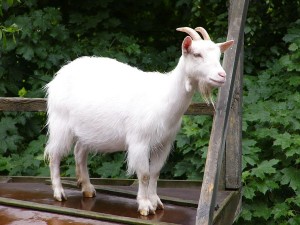You’re on a game show and the host asks you to pick one of three doors. Behind one of them is the star prize: a sports car. Behind the other two are goats. Once you have  made your pick, the show host opens one of the other doors – always revealing a goat. The host then asks if you are happy with your original choice, or whether would you like to switch.
made your pick, the show host opens one of the other doors – always revealing a goat. The host then asks if you are happy with your original choice, or whether would you like to switch.
Would you switch? Think about it before reading on.
The Monty Hall Problem
The Monty Hall Problem is based on a game show called Let’s Make a Deal, originally presented by Monty Hall.

This problem was posed to the mathematical community in a letter to The American Statistician in 1975, but was popularised by Marilyn Vos Savant in 1991.
Marilyn’s article suggested that the right thing to do is to switch. If you read the article – and please do – you will see that Marilyn received many very negative comments – some would say rude, to her conclusion. Here are some examples:
- “You blew it, and you blew it big! Since you seem to have difficulty grasping the basic principle at work here, I’ll explain. After the host reveals a goat, you now have a one-in-two chance of being correct. Whether you change your selection or not, the odds are the same. There is enough mathematical illiteracy in this country, and we don’t need the world’s highest IQ propagating more. Shame!“
- “Since you seem to enjoy coming straight to the point, I’ll do the same. You blew it! Let me explain. If one door is shown to be a loser, that information changes the probability of either remaining choice, neither of which has any reason to be more likely, to 1/2. As a professional mathematician, I’m very concerned with the general public’s lack of mathematical skills. Please help by confessing your error and in the future being more careful.“
- “Maybe women look at math problems differently than men.“
- “You are the goat!“
It is incredulous that people could write such comments and – and it is now accepted that Marilyn was correct and the right thing to do is to switch doors. There would have ben some red faces and I hope they apologised.
Solution
If you are faced with three doors and choose one of those at random, I think we’d all agree that you have a one in three (1/3) chance of choosing the car.

If one of the other doors is opened, showing a goat, one argument says that switching doors now gives you a 1/2 chance of winning the car.
Another argument says that once you have chosen a door, you have a 1/3 chance of winning the car. If you could choose the other two doors instead you would have a 2/3 chance of winning the car. If you are now showed one of these doors – revealing a goat – by switching, you still have a 2/3 chance of winning the car. Of course, you will not always win a car but over many games, by switching you will win 2/3 of the time, compared with only winning a 1/3 of the time if you do not switch.
There are two ways that might persuade you that switching is the right thing to do.
- Increase the number of doors to 50. When you choose a door you have a 1/50 chance of winning the car. This means that there is 49/50 chance that the car is behind one of the other doors. The host now opens all the remaining doors, just leaving your original door and one other. If you stick with your original door you still have a 1/50 chance of winning the car. If you switch, you have a 49/50 chance of winning the car.
- We can run a simulation. In preparing this article, I wrote a Java program to do that. We ran the Monty Hall Problem 5,000 times, both switching doors and not switching. If we have three doors, by not switching, the car was won 1702 times, compared to 3310 when switching. These are close enough to the 1/3 and 2/3 win ratios that we would expect. If we now change the number of boxes to 50, if we don’t swap we win the car 99 times. If we swap, we win 4,914 times. Again, this is close enough to the theoretical figures to persuade us that switching is the correct thing to do.
Hopefully, you are now persuaded that you should switch doors when faced with a similar situation. Good luck!
This post was also published on LinkedIn.
